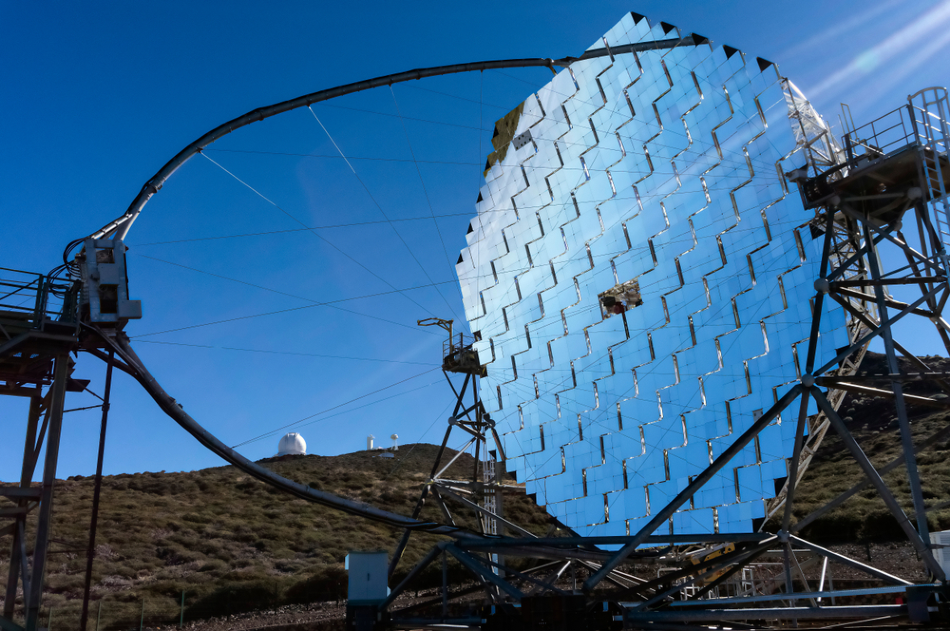Jan 9 2008

Image Credit: gopixa/Shutterstock.com
Article updated on 03/03/20 by Rebecca Ingle
A whole new world came to life for Alice when she passed through the looking glass – beetles with bad attitudes, Tweedledee and Tweedledum, smiling cats, talking tiger lilies and much more.
Mirrors have special powers in the real world too, especially in the hands of an astronomer and modern astronomy depends on mirrors. Almost every telescope uses a mirror, sometimes several mirrors, to gather and guide starlight toward some super-sensitive digital detector where a breathtaking image can be formed. Without mirrors, it would be almost impossible to study the universe.
.jpg)
Figure 1. Astronomers examine the 2.4-meter mirror at the heart of the Hubble Space Telescope.
An X-Ray Astronomer
For an X-ray astronomer, it's a little more complicated. "The X-ray light we use to study the Universe is so energetic, it would pass right through an ordinary mirror," laments Brian Ramsey of the Marshall Space Flight Center.
Therefore, Ramsey and colleagues have built an extraordinary sideways mirror that can harvest high-energy X-rays (also called "hard" X-rays)." It's called a grazing incidence mirror," explains Ramsey, who is HERO's lead scientist, "and it can guide very energetic X-rays."
Ramsey's team tested the device nicknamed HERO (short for High Energy Replicated Optics) on-board a balloon launched from Fort Sumner, New Mexico. The balloon carried HERO above 99% of Earth's atmosphere where it could gather X-rays from space. The images obtained from HERO were sufficiently impressive that in 2015, the device was upgraded to become SuperHERO, building upon the original technology.
.jpg)
Figure 2. HERO heads for the stratosphere.
The HERO Team
The HERO team is one of many scientific groups that asked the Columbia Scientific Balloon Facility experts at Fort Sumner to launch payloads via these enormous balloons.
At full inflation, HERO's balloon is 500 feet wide and rises 1000 feet above the payload. The balloon facility crew inflates and launches the balloons, tracks them, and recovers them. Because of the favorable wind conditions (little or no wind) in May and September, Fort Sumner is an excellent location for ballooning at those times.
People come out to watch and ask questions. One little boy asked me if our huge telescope had ever landed on a cow.
Brian Ramsey, Marshall Space Flight Center
(No!) Ramsey added that the Fort Sumner residents are very friendly and helpful. "They even put on barbecues for us from time to time," he says. Ramsey is used to hospitality, Southern hospitality, since Marshall Space Flight Center is in Huntsville, Alabama.
HERO's optics, designed and built-in Huntsville, includes 96 tube-like "grazing incidence" mirrors nested like the layers of an onion.
.jpg)
Figure 3. Like stones skipping across the surface of a pond, X-rays glance off the sides of grazing incidence mirrors.
Mirrors Must be Angled for X-Rays
Why the strange shape? Because high-energy X-rays would pass right through the kind of flat mirror we look at each morning over our toothpaste. To keep these high-energy photons from passing through, the mirrors must be angled so they are almost parallel to the beam, meaning the X-ray photon glance off the side. From there, the photons travel down the tubes to detectors that form an image.
When these mirrors make it to space, they will gather photons from some of the most violent objects in the Universe: exploding stars, colliding galaxies, and black holes, to name a few. The inner violence of these objects is what makes their photons so energetic and why astronomers need a high-energy X-ray telescope to study them.
.jpg)
Figure 4. Three of HERO's tube-shaped X-ray mirror shells (right) and a nested grouping of mirrors within one cylindrical tube (left).
HERO Team had to Climb a Slippery Slope
The HERO team had to climb a slippery slope to loft their innovative optics upward. Their first several attempts failed for different reasons with the weather being the worst obstacle.
We have daily weather briefings. When they say 'the weather is unsuitable for launch through next Wednesday,' you consider the prospect of yet another week or two in your motel room. And there are only two restaurants around, which you get tired of. And your spirits sink a little.
Brian Ramsey, Marshall Space Flight Center
Add to poor weather a few technical difficulties causing aborted flight attempts, and you get some frustrated scientists.
Ballooning is Difficult and Unpredictable
If ballooning is so difficult and unpredictable, why does this team rely on a balloon to give their experiment wings? Ramsey says the benefits outweigh the difficulties.
"A balloon mission costs much less than a satellite mission, about 1 million as opposed to 100 million and up," he explains. "The true beauty of ballooning lies in the fact that the payloads can be reused, and the turnaround time is fast. After landing via parachute, the team makes any repairs needed for the payload and prepares it to fly again within a year. Also, because of its short duration, a balloon mission provides a great training opportunity for a college student doing research for a thesis or dissertation."
HERO Missions
Ramsey and his team took their payload to several different areas, including Alice Springs, Australia.
Australia is an interesting place for us to fly because the galactic center is clearly visible from there. The galactic center is the most active part of our galaxy. It has lots of [hard X-ray] sources packed in there, and with our optics we will be able to resolve those into individual sources and capture images no one has captured to date.
Brian Ramsey, Marshall Space Flight Center
Meanwhile, a big white balloon drifts by, high in the New Mexican sky, dangling a telescope filled with mirrors that bring a whole new world to life. In Alice's words, "It's got, oh! Such beautiful things in it!"
Source